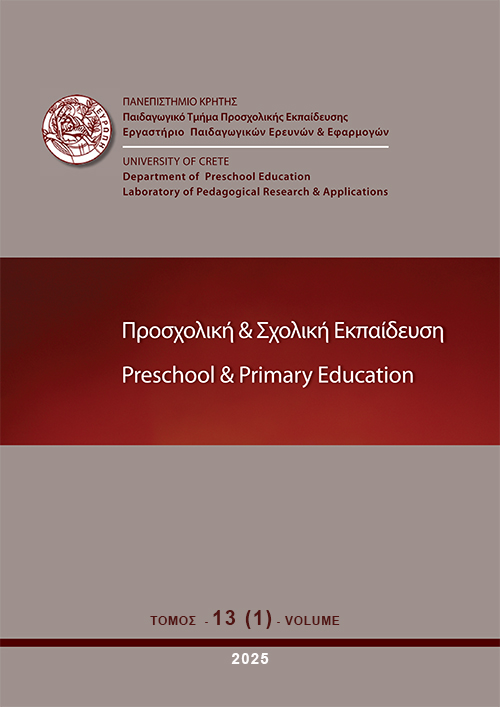Τhe implementation of an interactive educational intervention program using the Kinems learning games platform to improve gross motor skills in children with ASD

Περίληψη
Introduction: Autism spectrum disorder (ASD) is a developmental disorder that simultaneously affects several areas of development such as communication, cognition, socialization, and movement, causing at the same time stereotyped behavior to occur. Purpose of the study: The purpose of this study was to investigate the use of interactive educational games as part of an educational program to enhance gross motor development of primary school students with ASD. Method: In this two-phases study, a case-control design was applied using a 3-month interactive educational platform based intervention with 15 children with ASD, while a similar control group of 16 children with ASD followed their schools’ typical teaching methods. The mean age of the children was 9.2 ± 1.4 years old and the groups were adjusted for gender, age, body type and dominant foot or leg. During the first phase of the study, and before the beginning of the intervention, children’s gross mobility was measured using the latest version of the Test of Gross Motor Development TGMD (version 3.0.). Then, the intervention was conducted using a selected list of games from the interactive educational platform named Kinems. During the second phase of the study, children’s gross mobility was measured again, using the Test of Gross Motor Development-3. Results: The gross mobility scales, the TGMD-3 scores, showed significant differences in children in the intervention group compared to the children in the control group, specifically regarding two of the TGMD-3 skills, namely ‘gallop’ and ‘2-hand catch’ scores. In most of the thirteen activities studied, children in the intervention group showed higher mean differences compared to the children in the control group. %Mean Success score was corelated with equivalent ages based on Locomotor skills. Implications & conclusions: The findings suggest that the interactive educational intervention program applied with primary school children with ASD, had a positive effect in their gross motor skills.
Λεπτομέρειες άρθρου
- Πώς να δημιουργήσετε Αναφορές
-
Farsari, E., & Nitsiou, C. (2025). Τhe implementation of an interactive educational intervention program using the Kinems learning games platform to improve gross motor skills in children with ASD. Preschool and Primary Education, 13(1), 29–49. https://doi.org/10.12681/ppej.38379
- Ενότητα
- Άρθρα

Αυτή η εργασία είναι αδειοδοτημένη υπό το CC Αναφορά Δημιουργού – Μη Εμπορική Χρήση – Παρόμοια Διανομή 4.0.
Οι συγγραφείς των άρθρων που δημοσιεύονται στο ΠΡΟΣΧΟΛΙΚΗ & ΣΧΟΛΙΚΗ ΕΚΠΑΙΔΕΥΣΗ διατηρούν τα δικαιώματα πνευματικής ιδιοκτησίας επί των άρθρων τους, δίνοντας στο περιοδικό το δικαίωμα της πρώτης δημοσίευσης. Άρθρα που δημοσιεύονται στο ΠΡΟΣΧΟΛΙΚΗ & ΣΧΟΛΙΚΗ ΕΚΠΑΙΔΕΥΣΗ διατίθενται με άδεια Creative Commons 3.0 και σύμφωνα με την άδεια μπορούν να χρησιμοποιούνται ελεύθερα, με αναφορά στο/στη συγγραφέα και στην πρώτη δημοσίευση για μη κερδοσκοπικούς σκοπούς και με δικαίωμα τροποποίησης μόνον με παρόμοια διανομή (αν αναμείξετε, τροποποιήσετε, ή δημιουργήσετε πάνω στο υλικό, πρέπει να διανείμετε τις δικές σας συνεισφορές υπό την ίδια άδεια όπως και το πρωτότυπο). To Εργαστήριο Παιδαγωγικών Ερευνών και Εφαρμογών του Παιδαγωγικού Τμήματος Προσχολικής Εκπαίδευσης του Πανεπιστημίου Κρήτης και το Εθνικό Κέντρο Τεκμηρίωσης διατηρούν το δικαίωμα να δημοσιεύουν, να αναπαραγάγουν, να παρουσιάζουν στο κοινό, να διανέμουν και χρησιμοποιούν άρθρα που δημοσιεύονται στο ΠΡΟΣΧΟΛΙΚΗ & ΣΧΟΛΙΚΗ ΕΚΠΑΙΔΕΥΣΗ σε οποιοδήποτε μέσο και μορφή είτε μεμονωμένα είτε ως μέρη συλλογικών έργων, για όλο το χρόνο διάρκειας προστασίας της πνευματικής ιδιοκτησίας και για όλες τις χώρες του κόσμου. Αυτό περιλαμβάνει ενδεικτικά και όχι αποκλειστικά, το δικαίωμα δημοσίευσης των άρθρων σε τεύχη του περιοδικού ΠΡΟΣΧΟΛΙΚΗ & ΣΧΟΛΙΚΗ ΕΚΠΑΙΔΕΥΣΗ, αναπαραγωγής και διανομής μεμονωμένων αντιγράφων των άρθρων, αναπαραγωγής ολόκληρων των άρθρων σε άλλη έκδοση του Εργαστηρίου Παιδαγωγικών Ερευνών και Εφαρμογών του Παιδαγωγικού Τμήματος Προσχολικής Εκπαίδευσης του Πανεπιστημίου Κρήτης και του Εθνικού Κέντρου Τεκμηρίωσης και αναπαραγωγής και διανομής των άρθρων ή περίληψης αυτών με χρήση πληροφορικού συστήματος αποθετηρίου.


